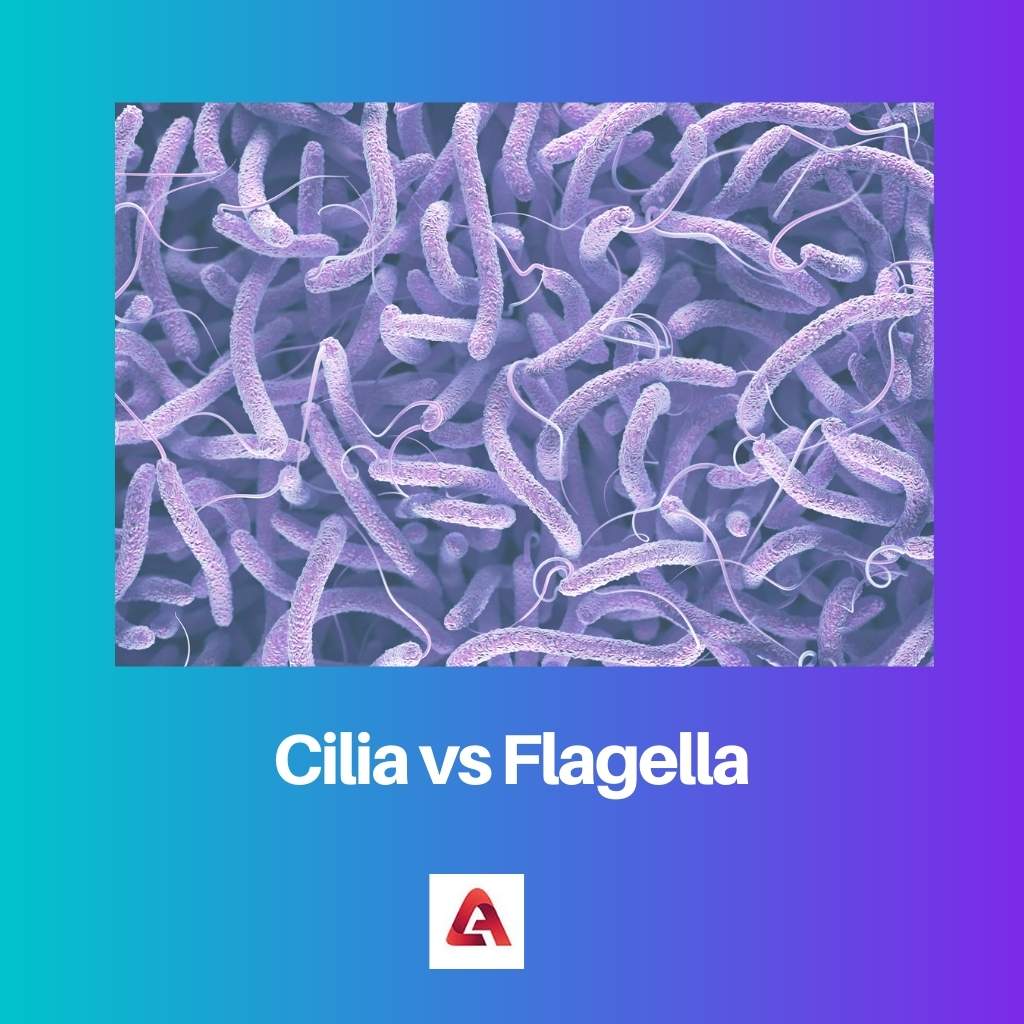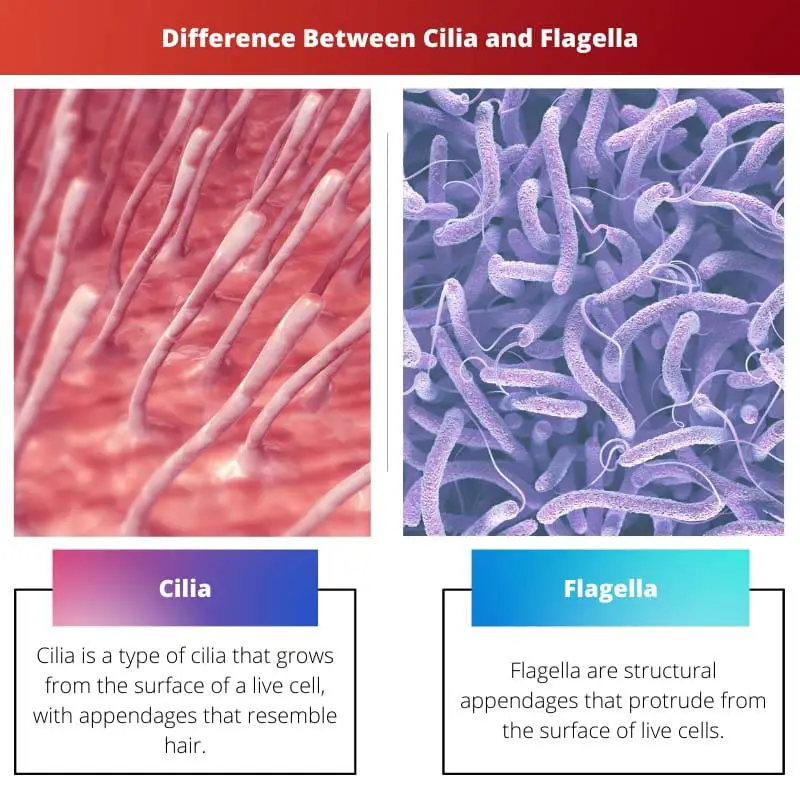The mobility, density, length, occurrence in quantity, and type of cell in which Cilia and Flagella are found are the differences between them. These are certain parts of a cell that have different functions and functionalities.
They differ in various parameters, such as their basic structure and shape as well. However, they have significant importance in the type of cells they are found in.
Key Takeaways
- Cilia are short, hair-like structures covering a cell’s surface, while flagella are long, whip-like appendages.
- Cilia function in movement and the transport of substances across the cell surface, whereas flagella primarily propel cells through their environment.
- Cilia occur in large numbers on a cell, while flagella are fewer in number or appear as a single structure.
Cilia vs Flagella
Cilia is a slender, small, hair-like structure that is found on the surface of the cells of all mammals and plays an important role in locomotion and mechanoreception. Flagella is a whip-like microscopic hair-like structure that is important in the locomotion of the cell, propelling it through liquid in the body.

Cilia is a type of cilia that grows from the surface of a live cell, with appendages that resemble hair. The number of Cilia is greater. Cilias are found all across the cell’s surface.
The Nexin arm can be found in a cross-section of Cilia’s organelles. Cilia have a high density of presence in live cells, which means that each cell contains hundreds of Cilia.
Flagella are structural appendages that protrude from the surface of live cells. Cilia has far fewer Flagellas than Flagellas. Flagella are found at the cell’s ends, in one or two places at most.
The Nexin arm is not present in a cross-section of Flagella organelles. The density of Flagella in a living cell is minimal, meaning that there are only ten or a few Flagellas in the cell.
Comparison Table
| Parameters of Comparison | Cilia | Flagella |
|---|---|---|
| Present in (number) | Many in number | Less in number |
| Length | Short | Long |
| Density | Hundreds/cell | Less than ten/cell |
| Occurrence | Throughout the cell surface | Only at the ends of a cell |
| Motion | Rotational motion, fast. | Wavelike motion, slow. |
| Found in | Eukaryotic cells | Prokaryotic and Eukaryotic cells. |
What is Cilia?
Cilias are normally small, ranging in size from 5 to 10 inches in length. Cilia extends from the live cell, or more precisely, from its surface, with appendages that resemble hair.
Cilia have a larger population. Cilias can be found on the cell’s whole surface.
The Nexin arm can be seen in a cross-section of Cilia’s organelles. Cilia have a high density of presence in living cells, which means that hundreds of Cilia can be found in a single cell.
Cilias beats in a metachronous or synchronous pattern. Their heartbeats have synchronised, either one after the other or all at once.
The Cilia move in a rotating manner, similar to a motor. Cilias move quickly. Cilias are organelles that can only be found in Eukaryotic cells. Cilias is primarily responsible for assisting in motility, aeration, circulation, and feeding.
Cilia can be seen in Paramecium in a few different forms.

What is Flagella?
The Flagella is normally quite lengthy, ranging between 150 and 200 millimetres. Flagella are thread-like structural extensions that sprout from the surface of a live cell.
The amount of Flagellas present is significantly lower than that of Cilia.
Flagella are commonly seen near the cell’s extremities, in one or two places at the most. The Nexin arm is missing from the cross-section of Flagella organelles.
The density of Flagella in a living cell is low, which means that there are only ten or a few Flagellas in the cell. Flagella have a slightly different beating style than Cilias.
Flagella beat at different speeds from one another. The Flagellants move at a snail’s pace when compared to Cilia. They have sinusoidal, undulating, and wave-like characteristics.
Flagella are organelles that can be found in both prokaryotic and eukaryotic cells. Flagellas’ primary role is to assist exclusively in locomotive activities. In Salmonella, the presence of Flagella might be seen in some cases.

Main Differences Between Cilia and Flagella
- The length of the Cilias is short, and their size ranges from 5µ to 10µ. On the other hand, the length of the Flagella is long, ranging around 150µ.
- Cilia extend from the living cell or, to be more precise, from its surface, possessing appendages that look similar to hair. On the other hand, Flagella are thread-like structural appendages that emerge from the living cell’s surface.
- Cilia are present more in number. On the other hand, the number in which Flagellas are present is much less than that of Cilia.
- Cilias can be spotted throughout the surface of the cell. On the other hand, Flagellas are present at the ends, either one or two or maximum places over the cell surface.
- At the cross-section of the organelles of Cilia, the Nexin arm is present. On the other hand, at the cross-section of the organelles of Flagellas, the Nexin arm is absent.
- The density of the presence of Cilia in a living cell is high, which means that hundreds of Cilia are present in a cell. On the other hand, the density of the presence of Flagella in a living cell is low, which means that less than ten or a few in number Flagellas are present in a cell.
- The beating process of Cilias occurs in a metachronous or synchronous manner. Their beating rhythm is coordinated either one after the other or simultaneously. On the other hand, the beating style of Flagellas is a bit different from that of Cilias. Flagella beat separately from one another.
- The motion of the Cilia is rotational, like a motor. Cilias move fast. On the other hand, in comparison to Cilia, the motion of the Flagellas is very slow. They are characterized by sinusoidal, undulating and wave-like features.
- Cilias are the type of organelles that are found only in Eukaryotic cells. On the other hand, Flagellas are the type of organelles that are found in both types of cells, that is, Prokaryotic and Eukaryotic.
- The main responsibility of Cilias is to provide aid in locomotion, aeration, circulation and feeding activities. On the other hand, the main responsibility of Flagellas is that they provide aid only in locomotive activities.
- Some examples of the presence of Cilia can be spotted in Paramecium. On the other hand, some examples of the presence of Flagella can be spotted in Salmonella.

- https://www.annualreviews.org/doi/pdf/10.1146/annurev.fl.09.010177.002011
- https://pdfs.semanticscholar.org/8188/3590a6c65da822f84e2b0fb6e80c3d05ae25.pdf

The detailed explanation of cilia and flagella in this article is a testament to the author’s expertise in the field. Well-researched and articulate!
The content is too technical and overly detailed. It could benefit from a more simplified explanation for non-experts.
I respectfully disagree, the depth of information in this article is highly beneficial for those seeking an in-depth understanding of cilia and flagella
The article’s humorous and comical tone in describing cilia and flagella adds an entertaining twist to an otherwise complex topic.
I found the humor to be refreshing and engaging, making the content even more enjoyable to read
The article does a great job of summarizing such complex biological concepts. Very informative and insightful!
Absolutely, the comparison table makes it so much easier to comprehend the differences between cilia and flagella
I couldn’t agree more, this article is a fantastic resource for understanding the intricacies of cilia and flagella
The article effectively clarifies the key differences between cilia and flagella, and the comparison table is particularly useful for quick reference.
The article explains the difference between cilia and flagella in great detail, providing a comprehensive understanding of these cell components!
I completely agree, the information is very detailed and well-explained
The author has managed to illuminate the intricacies of cilia and flagella in a way that is both entertaining and educational, a masterful combination!
Absolutely, the integration of humor with intellectual depth sets this article apart as a standout piece of scientific writing
This article’s comedic approach adds a delightful element to the discussion of cilia and flagella, making it an enjoyable read for all
The article provides an excellent analysis of cilia and flagella, highlighting their unique functions and characteristics in an expertly written manner.